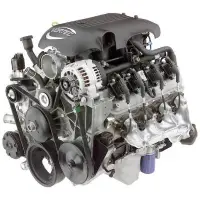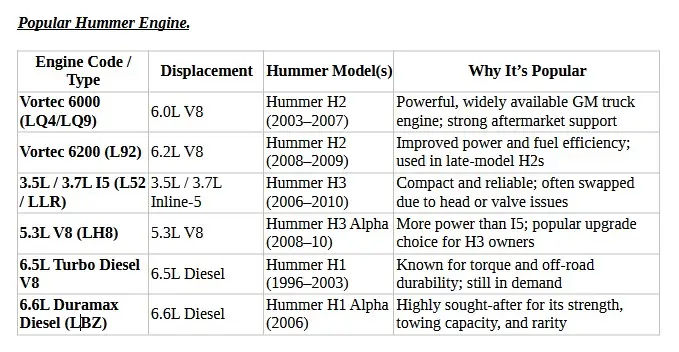Free shipping
On all orders over $499.00

Hummer, the name speaks for itself. A derivative or the civilian version of the US Military Humvee, the Hummer has the same strength and power that can urge the driver to go off-road and have the most amazing thrill that they cannot have while living in the Urban. Being Derived from the High Mobility Multipurpose Wheeled Vehicle or the HUMVEE, H1 and H2 are the most famous ones among the drivers of America. While the name Hummer can remind you of a military vehicle, what exactly makes this off-road vehicle appealing to the driver is the robust body and strong V8 engines, providing a feeling of toughness and commanding road presence to its driver.
However, any vehicle, sometimes with increasing mileage, becomes vulnerable to common engine wear and tear, which might be a subject of concern to the driver. Common issues like oil leaks, overheating, and others may lead to bigger ones like component failures. While some issues might be treated, others can impact up to that level of magnitude that engine replacement may become the only solution. While a cost-effective approach always seems to be the first choice of the driver, a used Hummer engine can always save you a significant fraction of the actual new engine cost.
Derived from the US Army Humvee, the Hummer is the best pickup to cover long off-road distances. With amazing features like the crabwalk, extract mode, and having the most power powertrain, the Hummer pickups are perfect for carrying heavy loads or someone who frequently goes off-roads following an adventure trail. With an amazing design, heavyweight body, and equipped with powerful V8 engines, H2 and H3 have now become the most popular off-road vehicle among American drivers.
While being heavyweight and oriented towards high performance, over time, with increased mileage, the Hummer engines become vulnerable to certain issues like overheating, oil leaks, cracked cylinders, and many others. While made only to travel off-road, under extreme conditions, damage to the engine can be a serious concern, and maybe up to that magnitude, the only solution seems to be engine replacement. While a brand-new engine can come up with high expenses, picking a used one is a cost-effective approach.
Heavy-Duty Engine Concept
Hummer engines-as in H2 and H1-are built for durability and performance, often based on GM V8 powertrains, such as the 6.0L Vortec or 6.5L turbo diesel. Opting for a used Hummer engine means you would get an essentially resilient, high-torque unit meant to take severe off-road abuse and towing incompatibilities.
OEM Fit and Compatibility
Used Hummer engines would directly mount to the existing mounts, transmissions, and electrical systems, especially when replaced with the same engine model. That would save you the trouble and extra cost of necessary modifications had you chosen an aftermarket or crate motor.
Built to Handle Extreme Conditions
Hummer engines were really meant to withstand the surface of the earth: rocky terrain, scorching heat, you name it. A good old, well-spanked, and maintained used engine will keep you in that type of environment with rugged reliability and will be best wrestled into heavy-duty use or for added performance off-road.
More Affordable than New or Custom Builds
New or remanufactured Hummer engines are costly because of their size and GM-based performance specs. A used engine has the same capacity and reliability at a considerably lower price, especially after being sourced from donor vehicles with low mileage.
Easier Maintenance and Parts Availability
In many cases, Hummer engines and GM trucks and SUVs share parts. Therefore, except for a few components, most of the parts for used Hummer engines are widely available and relatively inexpensive. Hence, future maintenance and repair procedures become much easier and cheaper.
Match the Engine Code and Model Year
Hummer engines, especially in the H2 and H3, often use GM-based V8s like the Vortec 6000 (6.0L) or inline-5s in the H3. Ensure the engine code matches your exact model and year to avoid issues with ECU, sensors, and fitment.
Check for Heavy-Duty Use
Hummers are always put through the torments of towing, off-roading, or tough utility work. Inspect the used engine for signs of excessive wear, overheating, or some internal damage. Usually, the engines from lightly used donor vehicles or rolled-over SUVs are the safest bets.
Ask For Compression or Leak-Down Test Results
In the case of a used engine, it is crucial for the driver to check the engine history, which major documentation to check for includes the Compression or the Leak-Down results. Based on these details, it is easy for the driver to determine the actual internal condition of the engine and determine for how much time the used engine is going to support you.
Check Included Components
While a used engine might be inexpensive, chances are likely that it may not be comprised of all the components like a manifold, fuel rails, sensors, or a wiring harness. Any missing component is one more addition to the driver's bill.
Buy from a Reputable Source
Select a vendor who offers warranty coverage, documentation, or a verified record of the vehicle's history. Engines from reputable salvage yards, suppliers specializing in General Motors, or from within the Hummer enthusiast community tend to be better in quality, with after-sales support.
Consider Mileage and Maintenance History
Cheaper are those with probably 60,000 miles and more but with a good maintenance record, while pricier are poorly maintained with less mileage. But an engine with 60,000 to 100,000 miles on it and decent maintenance is generally much better than the neglected low-mileage engine.
Not All GM Engines Are Plug-and-Play
Compatibility plays a crucial and also a major role while installing a used engine in the car. While all the Hummer engines are GM-based, based on their model type and year of manufacturing, they might be comprised of specific Hummer component that differentiates one engine from another. Therefore, it is recommended to check for specifications related to compatibility.
Proper Cooling System
Used Hummer engines are designed to work under extreme conditions with a large cooling system in place. When installing the replacement engine, make certain that the used engine is coupled with (or compatible with) the right radiator, fan assembly, and coolant routing. Early engine failure after installation is most often due to improper cooling.
Be Aware of the Torque Profile You Are Buying
Hummer engines provide low-end torque rather than high-speed horsepower output. When purchasing used, be sure that what you buy maintains the same torque curve, which is especially important if you are replacing a turbo diesel H1 engine or the 6.0L V8 in an H2 for substantial towing or off-road use.
On all orders over $499.00
You have 30 days Warranty
Payment 100% secure
Contact us 24 hours a day
Happy Customer
Engines & Transmission Sale
Inventory Yards
We Deals in Only
Yes, LS swaps are very possible but will need custom mounts, wiring, ECU tuning, and some work on the transmission. This is a very popular swap but fairly labor-intensive here in the U.S.
Avoid the 2003 and early 2004 H2 engines because they gave common problems with the 6.0L V8- oil consumption, sensor failures, etc. Later versions were better engineered and, hence, more reliable.
On a used Hummer engine, anything over 150,000 miles will be considered a high mileage. That being said, a number of engines exceed 200K miles of driving with the right maintainance.
The H2's V8 engine- either 6.0L or 6.2L- is the more powerful one and monger will definitely tend to outlast the inline-5 of the H3, whereas H3s will be cheaper to own with better fuel efficiency. So decide if you want more power or lower cost of ownership.
Hammer H3 is powered by a 3.5-liter or 3.7-liter inline-5 petrol engine, depending on the year. The initial model (2005–2006) came up with a 3.5L inline-5 engine, producing 242 horsepower and 242 lb fees. The latter models, including 2007, found an upgraded 3.7L inline -5 engine, which improved a slightly more power and torque, performance. These engines are naturally hopeful, which means they depend on atmospheric pressure rather than forced induction. Inline -5 configuration SUV is somewhat rare, providing a unique balance between medium -sized H3 -friendly power, efficiency and off -road capacity.
Lobster H1 is equipped with multiple engine options during production, the most famous 6.5-liter Detroit Diesel Turboladed V8 engine, which is known for credibility in its high torque and hard terrain conditions. Petrol engine options included 5.7-liter and 6.6-liter V8s, giving strong power, but usually less torque than the diesel version. These engines were designed to provide durability and robust performance, reflecting the military origin of H1 and civilian use in the extreme region and civilian use in heavy off-roading.
Our H2 is usually powered by a 6.0-liter V8 petrol engine known as the Vortec 6000. This engine produces around 325 horsepower and 365 lb-ft, providing H2 to strong terrain and Toking skills. The H2 model was later upgraded to the 6.2-liter V8 engine, which increases production approximately 393 horsepower and 415 lb-ft torque. Both engines are naturally hopeful and are based on the small and blocking V8 architecture of General Motors, which balances strength and reliability for this large SUV.
Repetition of the engine head in 2007 hummer H3 usually occurs between $300 and $ 2000, depending on the number of workshops, location and injury. This process includes removing the cylinder head, cleaning, inspecting for cracks or wars, restarting intercourse surfaces, and if necessary valves, valve guides and seals repair or replace or replace. If the head is seriously damaged or torn, further machining or replacement may be required, costs increase. The work frequency varies widely, with dealers who are usually more cost than independent stores. Given 3.5L or 3.7L -inline -5 engine, the availability of parts is decent, but somewhat specific. Overall, it is intelligent to receive a wide offer before continuing to secure the work, which fits the budget and provides a guarantee of store reconciliation.